


Over the past 30 years, China has developed rapidly to become the world’s second largest economy, reaching the status of a middle-income country. Realizing this success, however, has involved a development approach entailing massive and inefficient resource use, and extensive damage to the quality of air, water and soil. Transforming from a resource- and pollution-intensive economy to a green economy is now a strategic priority for China. Success depends on the development of green industries and the transformation and reduced importance of many traditional industries. Success will be built heavily on green finance, and this is where China is headed.
The aim of this book is to develop specific proposals for greening China’s financial system, based on an analysis of current practice in China and an exchange of experience with international experts. The book proposes a framework for actions covering five key areas that, if adopted by the Chinese government, would promote the systematic development of green finance:
A. Establish and strengthen legal frameworks, including environmental laws and law enforcement that contribute to the demand for green finance.
China’s central bank, the People’s Bank of China, has launched a ground-breaking report that sets out in specific and practical terms an ambitious agenda of how China can green its rapidly developing financial and capital markets.
The report, entitled “Establishing China’s Green Financial System”, is the outcome of a Green Finance Task Force which was tasked to develop policy, regulatory and market-innovations that would better align China’s financial system with the needs of green industry and sustainable development. The Task Force was co-convened by the Research Bureau of the People’s Bank of China (PBC) and the United Nations Environment Programme project Inquiry into the Design of a Sustainable Financial System (`UNEP Inquiry`).
